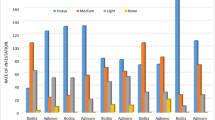Abstract
The geochemistry of available soil Se varies enormously in different localities, and the corresponding amounts moving up through crops to food vary accordingly. In a belt extending from northeastern to south central China, the available soil Se was measured by human blood Se levels. Severe deficiency occurred at 8–26 ng/mL; subadequate amounts occurred in large areas with 32–83 ng/mL; adequate amounts of 200–300 ng/mL occurred in large cities; and toxic amounts of 3000–7800 ng/mL occurred in terrace areas where runoff from the uplands evaporated, and in certain other soils. Some heart deaths (Keshan Disease) occurred in children 1 to 10 yr of age in the most deficient areas, but were prevented by 230–900 μg/wk Se supplementation. One mg Se/wk was the adult dosage. In Se deficient areas, the life span of adults was lowered severely (35 to 45 yr), with heart muscle damage common at autopsy. Se and Zn deficiencies are apparently associated with stomach cancer. The geochemistry of Se in the USA is also highly variable, blood Se ranging from 100–350 ng/mL. Se data for individuals are limited; however, ischemic heart death correlated inversely with blood Se in 25 cities of 22 states (r=−70;p<.01). Counties of Wisconsin and Florida are highly variable in human heart death and cancer death rates, as are the 50 states, suggesting Se geographic variability.
Similar content being viewed by others
References
W. Mertz,Science,213, 1332 (1981).
A. G. Cairns-Smith,Scient. Am. 252(6), 90 (1985).
R. Stocker, Y. Yamamoto, A. F. McDonagh, A. N. Glazer, and B. N. Ames,Science,235, 1043 (1987).
W. G. Hoekstra,Fed. Proc 34, 2083 (1975).
J. Kubota, W. H. Allaway, D. L. Carter, E. E. Cary, and V. A. Lazar,J. Agr. Food Chem. 15, 448 (1967).
G. F. Combs and S. B. Combs, The Role of Selenium in Nutrition, Academic, New York, p. 532.
M. L. Jackson and C. H. Lim, in7th Intl. Clay Conf. Proc. 1981, H. van Olphen and F. Veniale, ed., Elsevier, Amsterdam, 1982, pp. 641–653.
C. S. Li and M. L. Jackson, inTrace Substances in Environmental Health, vol. 19, D. D. Hemphill, ed., University of Missouri, Columbia, MO, 1985, pp. 264–276.
R. J. Shamberger,Biochemistry of Selenium, Plenum, New York, 1983, p. 334.
M. L. Jackson,Appl. Geochem.,1, 175 (1986).
M. S. Eisenberg, L. Bergner, A. P. Hallstrom, and R. O. Cummins,Scient. Am. 254(5), 37 (1986).
E. M. Leeper,National Academy of Sciences News,32(3), 12 (1982).
L. M. Klevay,Ann. New York Acad. Sci., vol. 355, O. E. Levander and L. Cheng, ed. New York, 1980, pp. 140–151.
J. McBride,Agri. Res. 33(9), 6 (1985).
E. J. Underwood, inBiochem. Nutr-1A, vol. 27, A. Neuberger and T. H. Jukes, ed., University Park Press, MD, 1979, pp. 207–243.
Metropolitan Life Insurance Co., PitStatis. Bull.65(3), 8 (1984).
M. Howe,Arch. Environ. Health,34, 444 (1979).
G. N. Schrauzer, inAdvances in Nutritional Research, vol. 2, H. H. Draper, ed., Plenum, New York, 1979, pp. 219–244.
G. N. Schrauzer and J. E. McGinnes, inTrace Substances in Environmental Health, vol. 13, D. D. Hemphill, ed., University of Missouri, Columbia, MO, 1979, pp. 64–67.
G. N. Schrauzer and D. A. White,Bioinorg. Chem.,8, 303 (1978).
W. L. Stone, M. E. Stewart, C. Nicholas, and S. Pavuluri,Ann. Nutr. Metab. 30(2), 94 (1986).
W. H. Allaway, J. Kubota, F. Losee, and M. Roth,Arch. Environ. Health,16, 342 (1968).
O. A. Levander inClinical, Biochemical, and Nutritional Aspects of Trace Elements, A. S. Prasad, ed., Liss, New York, 1982, pp. 345–368.
S. Y. Yu, Y. J. Chu, X. L. Gong, C. Hou, W. G. Li, H. M. Gong, and J. R. Xie,Biol. Trace Element Res. 7, 21 (1985).
M. L. Jackson, J. Z. Zhang, C. S. Li, and D. F. Martin,Appl. Geochem. 1, 487 (1986).
J. T. Salonen, R. Salonen, R. Lappetelainen, P. H. Maenpaa, G. Althan, and P. Puska,Br. Med. J. 290, 417 (1985).
H. H. Draper and R. P. Bird,J. Agric. Food Chem. 32, 433 (1984).
H. J. Thompson,J. Agric. Food Chem. 32, 433 (1984).
G. A. Babenko, I. P. Pogribnyi, and I. I. Mashchakevich,Eksp. Onkol. 8(4), 31 (1986) (in Russian).
G. N. Schrauzer, D. A. White, and C. J. Schneider,Bioinorg. Chem. 7: 23 (1977).
M. L. Jackson, J. Z. Zhang, and C. S. Li,Trans. Wis., Acad. Sci., Arts, Lett.,73, 35 (1985).
M. L. Jackson, C. S. Li, and D. F. Martin,Fla. Scient. 49, 82 (1986).
US National Academy of Sciences,Aging and the Geochemical Environment, Washington, DC, 1981.
D. L. Grunes and W. H. Allaway, inFertilizer Technology and Use, 3rd edn., O. P. Engelstad, ed., Soil Science Society of America, Madison, WI, 1985, pp. 589–619.
F. J. Kok, J. P. van denbrouche, C. van der Heide-Wessel and R. M. van der Heide,Am. J. Epidemiol. 123, 1043 (1986).
M. S. Seelig,Magnesium Deficiency in the Pathogenesis of Disease: Early Roots of Cardiovascular Skeletal, and Renal Abnormalities. Plenum, New York, 1980.
V. Eybl, J. Sykorna, and F. Mertl,Acta Pharmacol. Toxicol. Suppl. 59(7), 547 (1986).
H. Ohta, and S. Imamiya,Kitasato Arch. Exp. Med. 59(1–2), 27 (1986).
L. Kosta, V. Zelenko, and A. R. Byrne, inHommage Professeur Rene Truhaut, Fac. Pharm., Paris, Fr., 1984, pp. 576–580.
W. T. Buckley, S. N. Huckin, L. J. Fisher, and G. K. Eigendorf,Can. J. Anim. Sci.,66(4), 1009 (1986).
E. L. Schneider and J. D. Reed,N. Engl. J. Med. 312, 1159 (1985).
S. B. Eaton and M. Konner,N. Engl J. Med. 312, 283 (1985).
J. Cairns,Scient. Am. 253(5), 51 (1985).
H. C. Hopps and B. L. O’Dell,Federation Proc. 40, 2112 (1981).
US National Academy of Sciences,Recommended Daily Allowances, 9th ed., Washington, DC, 1980.
Author information
Authors and Affiliations
Rights and permissions
About this article
Cite this article
Jackson, M.L. Selenium: Geochemical distribution and associations with human heart and cancer death rates and longevity in China and the United States. Biol Trace Elem Res 15, 13–21 (1988). https://doi.org/10.1007/BF02990124
Received:
Accepted:
Issue Date:
DOI: https://doi.org/10.1007/BF02990124




